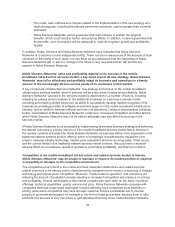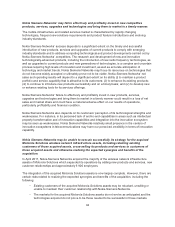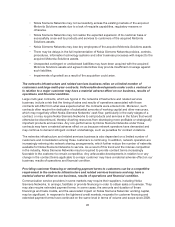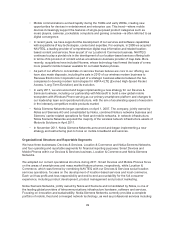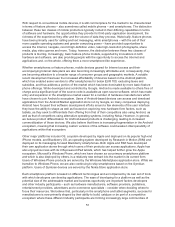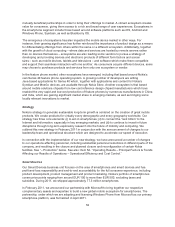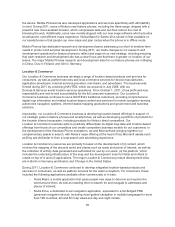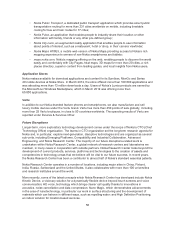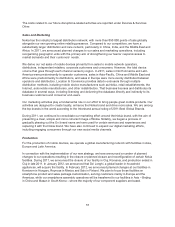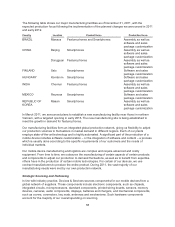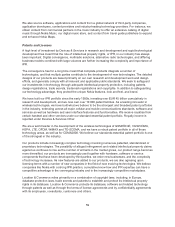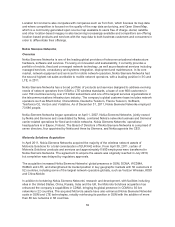Nokia 2011 Annual Report Download - page 54
Download and view the complete annual report
Please find page 54 of the 2011 Nokia annual report below. You can navigate through the pages in the report by either clicking on the pages listed below, or by using the keyword search tool below to find specific information within the annual report.mutually beneficial partnerships in order to bring their offerings to market. A vibrant ecosystem creates
value for consumers, giving them access to a rich and broad range of user experiences. Ecosystems in
the smartphone segment include those based around software platforms such as iOS, Android and
Windows Phone, Symbian, as well as Blackberry OS.
The emergence of ecosystems has also impacted the mobile device market in other ways. For
instance, their growing significance has further reinforced the importance of product design as a means
for differentiating offerings from others within the same or a different ecosystem. Additionally, together
with the growth of cloud computing – where data and services are hosted by remote servers rather
than on devices themselves – ecosystems are also leading some vendors to pursue a strategy of
developing and providing devices and electronic products of different form factors and screen
sizes – such as mobile devices, tablets and televisions – and software which make them compatible
and support their seamless interaction with one another. As consumers acquire different devices, some
may choose to purchase products and services from only one ecosystem or vendor.
In the feature phone market, other ecosystems have emerged, including that based around Nokia’s
own Series 40 feature phone operating system. A growing number of developers are writing
Java-based applications for Series 40 which, together with applications and content for Nokia’s
Symbian and MeeGo devices, are available through Nokia Store. Another ecosystem is that based
around mobile solutions chipsets from low-cost reference design chipset manufacturers which have
enabled the very rapid and low-cost production of feature phones by numerous manufacturers in China
and India, which are gaining significant market share in emerging markets, as well as bringing some
locally relevant innovations to market.
Strategy
Nokia’s strategy to generate sustainable long-term growth is centered on the creation of great mobile
products. We create products for virtually every demographic and every geography worldwide. Our
strategy has three core elements: (i) to win in smartphones; (ii) to connect the “next billion” to the
Internet and information, especially in key emerging markets; and (iii) to continue to invest in future
disruptions through long-term exploratory research into the future of mobility and computing. We
outlined this new strategy in February 2011 in conjunction with the announcement of changes to our
leadership team and operational structure which are designed to accelerate our speed of execution.
In connection with the implementation of our new strategy, we have announced a number of changes
to our operations affecting personnel, including substantial personnel reductions in different parts of the
company, and resulting in the closure and planned closure and reconfiguration of certain Nokia
facilities. See “– Production” below. See also: Item 5A. “Operating Results – Principal Factors & Trends
Affecting our Results of Operations – Operational Efficiency and Cost Control.”
Smart Devices
Our Smart Devices business unit focuses on the area of smartphones and smart devices and has
profit-and-loss responsibility and end-to-end accountability for the full consumer experience, including
product development, product management and product marketing. Nokia’s portfolio of smartphones
covers price points ranging from around EUR 100 to more than EUR 500, excluding taxes and
subsidies. During 2011, we shipped approximately 77.3 million smartphones.
In February 2011, we announced our partnership with Microsoft to bring together our respective
complementary assets and expertise to build a new global mobile ecosystem for smartphones. The
partnership, under which we are adopting and licensing Windows Phone from Microsoft as our primary
smartphone platform, was formalized in April 2011.
52


